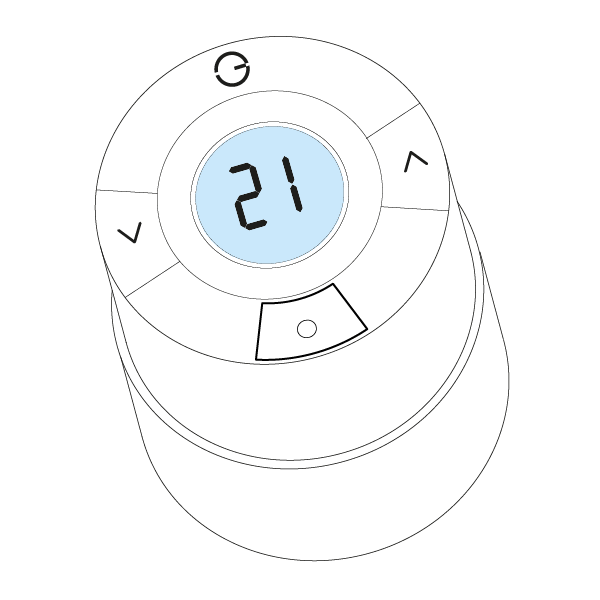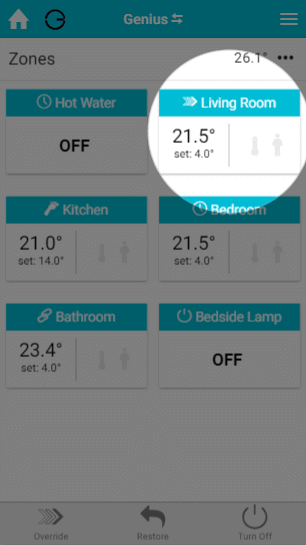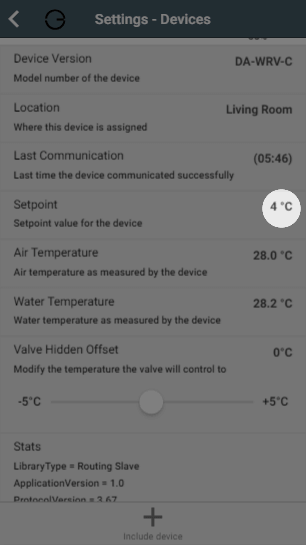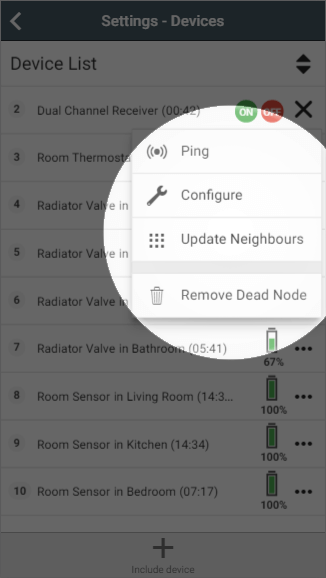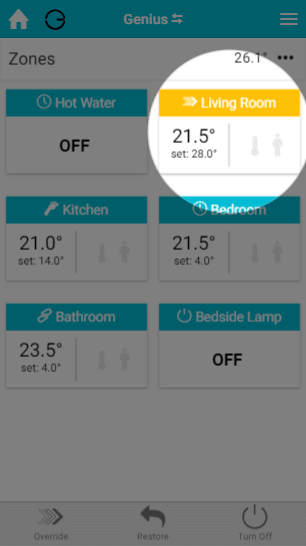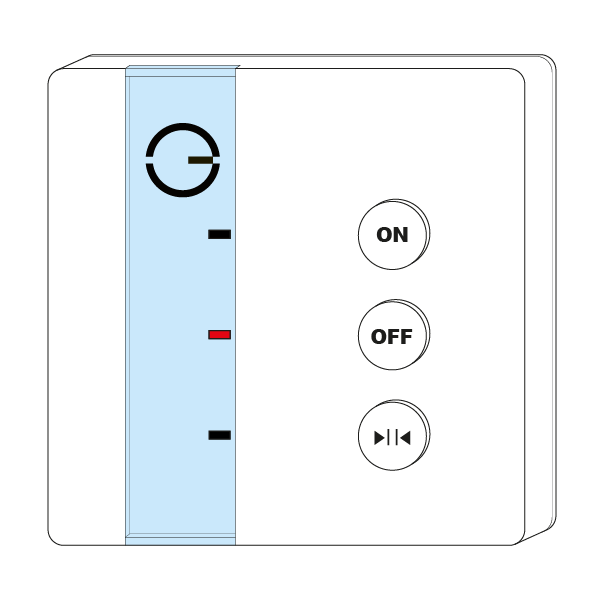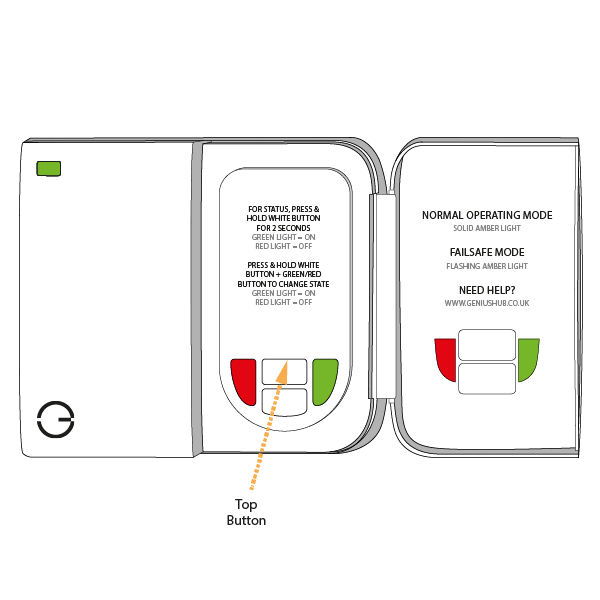How to test the system
If one of your radiators is not heating up, there are a number of possible reasons which could be responsible, some of which are part of the Genius Hub system. The following procedure will help you to determine which part of the system is not working.
Confirming the Genius Radiator Valve is communicating
- Load up the My House page of the app.
- Check to see if there are any errors reported in the 'System' tile at the top of the screen.
- If so, look for the Genius Radiator Valve for this zone.
- If there is an error with this device, click on the error to be guided through how to fix it.
- If there are no errors, go to the radiator zone and override it to '4°C'.
- This should be a significant amount below the set temperature.
- The heating indicator for this zone should turn blue.
- Click on the Main Menu.
- Select 'Settings'.
- Choose 'Devices'.
- Locate your Genius Radiator Valve for this zone and click on the row to expand it. The setpoint should say 4°C.
- If it displays an arrow to 4°C, you will need to wake up the Genius Radiator Valve by pressing once on the right )^) button. The time since last communication should return to near 00:00 and the setpoint should update.
- The Genius Radiator Valve should now show 4°C on the screen if you wake it up.
- If the device does not say 4°C, click on the device submenu (•••) in the app and choose 'Configure'.
- Confirm that you want to proceed by pressing 'Configure'.
- Now click on the device submenu (•••) and choose 'Ping' and confirm this.
- Wake up the Genius Radiator Valve by pressing the right )^) button.
- The time since last communication should return to near 00:00 and the setpoint should say 4°C.
- Return to the My House page, and select the radiator zone once more.
- Override it to '28°C'.
- The heating indicator for this zone should turn orange.
- Click on the Main Menu.
- Select 'Settings'.
- Choose 'Devices'.
- Locate your Genius Radiator Valve for this zone and click on the row to expand it. The setpoint should say 28°C.
- If it displays an arrow to 28°C, you will need to wake up the Genius Radiator Valve by pressing once on the right )^) button. The time since last communication should return to near 00:00 and the setpoint should update.
- The Genius Radiator Valve should now show 4°C on the screen if you wake it up.
- If the device does not say 28°C, click on the device submenu (•••) in the app and choose 'Configure'.
- Confirm that you want to proceed by pressing 'Configure'.
- Now click on the device submenu (•••) and choose 'Ping' and confirm this.
- Wake up the Genius Radiator Valve by pressing the right )^) button.
- The time since last communication should return to near 00:00 and the setpoint should say 28°C.
- The fact that the Genius Radiator Valve displays 28°C, on the device and app shows that it is communicating correctly.
Confirming the boiler controller is working
The instructions below are for a Dual Channel Receiver, however your boiler may also be controlled by a Single Channel Receiver (image below).
The notes will explain where this differs for testing.
- Open the door on the Dual Channel Receiver and read from the labels on the inside of the door, which white button control the heating (it is normally the upper button).
- Press and hold the relevant white button. The light should turn green to confirm that the Dual Channel Receiver is calling for heat. If you have a Single Channel Receiver Receiver, a green light should appear on the front.
- The fact that the boiler controller shows a green light, shows that it is communicating and responding correctly.
- If the light turns red and you have not configured the Dual Channel Receiver during this testing:
- To fix this, click on the device submenu (•••) and choose 'Configure'.
- Confirm that you want to proceed by pressing 'Configure'.
- Now click on the device submenu (•••) and choose 'Ping' and confirm this.
- The time since last communication should return to near 00:00.
- Press the white button and the light should now turn green. If you have a Single Channel Receiver, the green light should appear now
- To fix this, click on the device submenu (•••) and choose 'Configure'.
- If the light turns red and you have configured the Dual Channel Receiver during this testing:
- See this article for re-adding the Dual Channel Receiver to your system.
- See this article for re-adding the Single Channel Receiver to your system.
- If the light on the Dual Channel Receiver turns green when you press the heating button, the zone valve should open and the boiler fire.
- To check the zone valve is working, go to where the zone valves are located, this is normally next to the boiler. A zone valve is a silver metal box attached to a large brass valve in the pipework from the boiler, which has wires going to it. This shuts opens and closes the flow of water around your system based on when there is a call for heat.
- On the side of the zone valve should be a lever.
- When you try to move the lever, if it is:
- Difficult to move, then there is a problem with the zone valve or the wiring between the Dual Channel Receiver and zone valve. You should get a qualified plumber to look at and fix this.
- Easy to move, then there is not a problem with the motor on the zone valve, but there is a problem wiring between zone valve and boiler, or a problem with the boiler. You should get a qualified plumber to look at and fix this. Alternatively, see this article for some common problems with the boiler which may be the cause of the problem.
- If you have a Single Channel Receiver, you may have a combination boiler without zone valves.
- In this case, when the light is green, the boiler should fire.
- If the boiler does not fire, the boiler may need to be checked that it has power, suitable water pressure and no error codes on the front of the boiler. You should get a qualified plumber to look at and fix this. Alternatively, see this article for some common problems with the boiler which may be the cause of the problem.
Confirming the Genius Radiator Valve can open/shut off the flow of water
- With the radiator zone overriden to 28°C, the zone orange on the app and the boiler running hot water should now start to flow around the system.
- Wait 10 minutes and go to the radiator in question and press the right )^) button. You should see 28°C on the screen of the device.
- Gently try to rotate the Genius Radiator Valve. The head should spin freely, but not leave the radiator.
- The Genius Radiator Valve has fully retracted the plunger and in turn the pin is now free for let water pass.
- If the Genius Radiator Valve is not turning freely, press the right )^) button once more and wait 10 minutes. It is possible the valve was asleep and has not had time to open yet.
- The radiator nearest the Genius Radiator Valve (and the pipe beneath) should now start to heat up.
Be careful when checking the radiator as it may be very hot and burn if due care is not taken.
If the Genius Radiator Valve is turning easily but the radiator is not heating up, either the hot water has not been pumped this far from the boiler, in which case waiting a few minutes longer will fix this; or the pin in the valve body underneath the Genius Radiator Valve has seized.
- The fact that the Genius Radiator Valve turns freely shows that it is working correctly.
- If the radiator is still not heating up, the seized pin will have to be freed or the valve body replaced. To try to free the pin, remove the valve head from the radiator, and with a pair of pliers or end of a large spanner, gently work the pin on the valve body free. Be careful when doing this as if the valve body is in poor condition, it may cause the valve body to leak. Once the pin is free, remount the valve head. See this link for removing and remounting the Genius Radiator Valve.
If it's not possible to free up the pin on the valve body, it will need to be replaced.
More information
- Now that you have proven that the Genius Radiator Valve can control the radiator, you may want to see this article which explains using an offset to ensure that the Genius Radiator Valve can control the radiator accurately.
